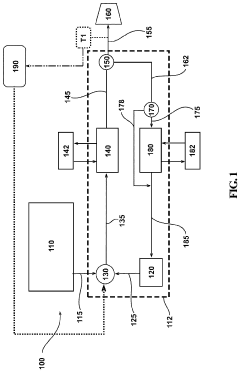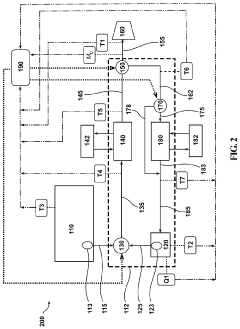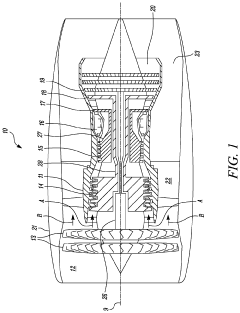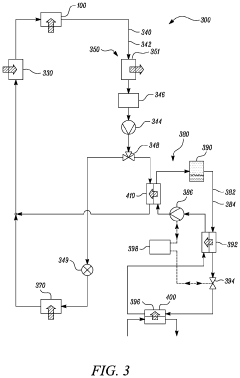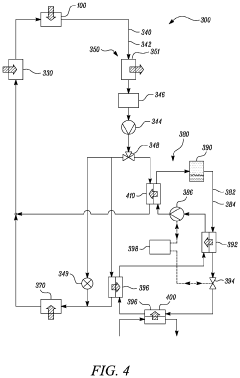Hastelloy Advances in Aerospace Thermal Management
JUL 10, 20259 MIN READ
Generate Your Research Report Instantly with AI Agent
Patsnap Eureka helps you evaluate technical feasibility & market potential.
Hastelloy Aerospace Evolution
Hastelloy, a family of nickel-chromium-molybdenum superalloys, has undergone significant evolution in aerospace applications, particularly in thermal management systems. The journey of Hastelloy in aerospace began in the mid-20th century, with its exceptional corrosion resistance and high-temperature strength making it an ideal candidate for aircraft components exposed to extreme conditions.
In the 1960s and 1970s, as aerospace technology advanced rapidly, the demand for materials capable of withstanding higher temperatures and more corrosive environments increased. Hastelloy alloys, particularly Hastelloy X and Hastelloy C, gained prominence in aircraft engine components and exhaust systems. These alloys demonstrated superior resistance to oxidation and maintained structural integrity at temperatures exceeding 1000°C, a critical requirement for jet engine applications.
The 1980s and 1990s saw further refinement of Hastelloy compositions, with the introduction of Hastelloy N and Hastelloy S. These variants were specifically engineered to address the unique challenges of aerospace thermal management, offering improved creep resistance and thermal stability. This period marked a significant leap in the alloy's capabilities, enabling its use in more advanced and demanding aerospace applications.
As the aerospace industry entered the 21st century, the focus shifted towards developing lighter and more efficient aircraft. This trend drove the evolution of Hastelloy towards alloys with higher strength-to-weight ratios and enhanced thermal properties. The introduction of Hastelloy C-22 and C-276 represented a major breakthrough, offering exceptional resistance to a wide range of corrosive media while maintaining excellent mechanical properties at elevated temperatures.
Recent advancements in Hastelloy technology have focused on optimizing its microstructure and composition to further improve its performance in aerospace thermal management systems. Researchers have explored the addition of rare earth elements and fine-tuning of alloying elements to enhance high-temperature stability and reduce thermal expansion. These developments have led to the creation of new Hastelloy variants specifically tailored for advanced aerospace applications, such as hypersonic aircraft and next-generation jet engines.
The evolution of Hastelloy in aerospace has been closely tied to advancements in manufacturing processes. Techniques such as powder metallurgy and additive manufacturing have enabled the production of complex Hastelloy components with improved properties and reduced weight. These manufacturing innovations have expanded the potential applications of Hastelloy in aerospace thermal management, allowing for the creation of intricate cooling systems and heat exchangers that were previously impossible to fabricate.
Looking ahead, the continued evolution of Hastelloy in aerospace is likely to focus on further enhancing its high-temperature capabilities, reducing weight, and improving its compatibility with advanced manufacturing techniques. As the aerospace industry pushes towards more efficient and environmentally friendly aircraft, the role of Hastelloy in thermal management systems is expected to grow, driving ongoing research and development in this critical alloy family.
In the 1960s and 1970s, as aerospace technology advanced rapidly, the demand for materials capable of withstanding higher temperatures and more corrosive environments increased. Hastelloy alloys, particularly Hastelloy X and Hastelloy C, gained prominence in aircraft engine components and exhaust systems. These alloys demonstrated superior resistance to oxidation and maintained structural integrity at temperatures exceeding 1000°C, a critical requirement for jet engine applications.
The 1980s and 1990s saw further refinement of Hastelloy compositions, with the introduction of Hastelloy N and Hastelloy S. These variants were specifically engineered to address the unique challenges of aerospace thermal management, offering improved creep resistance and thermal stability. This period marked a significant leap in the alloy's capabilities, enabling its use in more advanced and demanding aerospace applications.
As the aerospace industry entered the 21st century, the focus shifted towards developing lighter and more efficient aircraft. This trend drove the evolution of Hastelloy towards alloys with higher strength-to-weight ratios and enhanced thermal properties. The introduction of Hastelloy C-22 and C-276 represented a major breakthrough, offering exceptional resistance to a wide range of corrosive media while maintaining excellent mechanical properties at elevated temperatures.
Recent advancements in Hastelloy technology have focused on optimizing its microstructure and composition to further improve its performance in aerospace thermal management systems. Researchers have explored the addition of rare earth elements and fine-tuning of alloying elements to enhance high-temperature stability and reduce thermal expansion. These developments have led to the creation of new Hastelloy variants specifically tailored for advanced aerospace applications, such as hypersonic aircraft and next-generation jet engines.
The evolution of Hastelloy in aerospace has been closely tied to advancements in manufacturing processes. Techniques such as powder metallurgy and additive manufacturing have enabled the production of complex Hastelloy components with improved properties and reduced weight. These manufacturing innovations have expanded the potential applications of Hastelloy in aerospace thermal management, allowing for the creation of intricate cooling systems and heat exchangers that were previously impossible to fabricate.
Looking ahead, the continued evolution of Hastelloy in aerospace is likely to focus on further enhancing its high-temperature capabilities, reducing weight, and improving its compatibility with advanced manufacturing techniques. As the aerospace industry pushes towards more efficient and environmentally friendly aircraft, the role of Hastelloy in thermal management systems is expected to grow, driving ongoing research and development in this critical alloy family.
Thermal Management Demands
The aerospace industry's relentless pursuit of enhanced performance and efficiency has placed unprecedented demands on thermal management systems. As aircraft and spacecraft designs evolve to incorporate more powerful engines, advanced electronics, and lightweight materials, the challenge of effectively dissipating heat has become increasingly critical. Thermal management in aerospace applications must address a wide range of temperatures, from the extreme cold of high altitudes to the intense heat generated by propulsion systems and aerodynamic friction.
In modern aircraft, the integration of more electric systems and the trend towards "more electric aircraft" (MEA) concepts have significantly increased the heat load that must be managed. These systems generate substantial amounts of waste heat that, if not properly controlled, can lead to reduced performance, reliability issues, and even system failures. The demand for thermal management solutions that can handle these increased heat loads while maintaining or reducing overall system weight is a key driver in the industry.
For spacecraft and satellites, thermal management is even more crucial due to the extreme temperature variations encountered in space environments. The absence of atmospheric convection in space necessitates innovative approaches to heat dissipation, relying primarily on conduction and radiation. The need for materials and systems that can withstand rapid temperature cycling while maintaining structural integrity and performance is paramount.
The push for hypersonic flight capabilities has further intensified thermal management challenges. At hypersonic speeds, aerodynamic heating can cause surface temperatures to exceed 2000°C, requiring advanced materials and cooling systems to protect critical components and maintain structural integrity. This extreme thermal environment demands solutions that can withstand and effectively manage heat loads far beyond those encountered in conventional flight regimes.
Moreover, the aerospace industry's focus on sustainability and environmental impact has added another dimension to thermal management demands. There is a growing need for systems that not only effectively manage heat but do so with minimal energy consumption and environmental impact. This includes the development of more efficient heat exchangers, the use of environmentally friendly coolants, and the exploration of novel heat dissipation methods that reduce overall energy requirements.
In modern aircraft, the integration of more electric systems and the trend towards "more electric aircraft" (MEA) concepts have significantly increased the heat load that must be managed. These systems generate substantial amounts of waste heat that, if not properly controlled, can lead to reduced performance, reliability issues, and even system failures. The demand for thermal management solutions that can handle these increased heat loads while maintaining or reducing overall system weight is a key driver in the industry.
For spacecraft and satellites, thermal management is even more crucial due to the extreme temperature variations encountered in space environments. The absence of atmospheric convection in space necessitates innovative approaches to heat dissipation, relying primarily on conduction and radiation. The need for materials and systems that can withstand rapid temperature cycling while maintaining structural integrity and performance is paramount.
The push for hypersonic flight capabilities has further intensified thermal management challenges. At hypersonic speeds, aerodynamic heating can cause surface temperatures to exceed 2000°C, requiring advanced materials and cooling systems to protect critical components and maintain structural integrity. This extreme thermal environment demands solutions that can withstand and effectively manage heat loads far beyond those encountered in conventional flight regimes.
Moreover, the aerospace industry's focus on sustainability and environmental impact has added another dimension to thermal management demands. There is a growing need for systems that not only effectively manage heat but do so with minimal energy consumption and environmental impact. This includes the development of more efficient heat exchangers, the use of environmentally friendly coolants, and the exploration of novel heat dissipation methods that reduce overall energy requirements.
Hastelloy Limitations
Despite its remarkable properties, Hastelloy faces several limitations in aerospace thermal management applications. One significant challenge is its high cost compared to other alloys, which can restrict its widespread adoption in cost-sensitive aerospace projects. The complex manufacturing process and limited availability of raw materials contribute to this elevated price point, potentially impacting the overall economic feasibility of thermal management systems utilizing Hastelloy.
Another limitation is the difficulty in machining and forming Hastelloy components. The alloy's high strength and work-hardening characteristics, while beneficial for its performance, make it challenging to shape and fabricate into complex geometries often required in aerospace thermal management systems. This can lead to increased production time and costs, as well as potential design constraints.
Hastelloy's thermal conductivity, although superior to many other corrosion-resistant alloys, is still lower than that of some competing materials used in thermal management. This limitation may necessitate thicker components or more complex designs to achieve the desired heat transfer rates, potentially increasing weight and system complexity in aerospace applications where every gram matters.
The alloy's susceptibility to certain types of corrosion under specific conditions also presents a limitation. While Hastelloy exhibits excellent overall corrosion resistance, it can be vulnerable to stress corrosion cracking in certain environments, particularly those containing chlorides at elevated temperatures. This vulnerability requires careful consideration of operating conditions and may limit its applicability in some aerospace thermal management scenarios.
Furthermore, the long-term stability of Hastelloy under extreme thermal cycling conditions typical in aerospace applications is an area of ongoing research. While the alloy demonstrates good overall performance, there are concerns about potential microstructural changes and property degradation over extended periods of high-temperature exposure and rapid temperature fluctuations.
Lastly, the welding and joining of Hastelloy components can be challenging, requiring specialized techniques and expertise. Improper welding can lead to reduced corrosion resistance in the heat-affected zones, potentially compromising the integrity of thermal management systems in critical aerospace applications.
Another limitation is the difficulty in machining and forming Hastelloy components. The alloy's high strength and work-hardening characteristics, while beneficial for its performance, make it challenging to shape and fabricate into complex geometries often required in aerospace thermal management systems. This can lead to increased production time and costs, as well as potential design constraints.
Hastelloy's thermal conductivity, although superior to many other corrosion-resistant alloys, is still lower than that of some competing materials used in thermal management. This limitation may necessitate thicker components or more complex designs to achieve the desired heat transfer rates, potentially increasing weight and system complexity in aerospace applications where every gram matters.
The alloy's susceptibility to certain types of corrosion under specific conditions also presents a limitation. While Hastelloy exhibits excellent overall corrosion resistance, it can be vulnerable to stress corrosion cracking in certain environments, particularly those containing chlorides at elevated temperatures. This vulnerability requires careful consideration of operating conditions and may limit its applicability in some aerospace thermal management scenarios.
Furthermore, the long-term stability of Hastelloy under extreme thermal cycling conditions typical in aerospace applications is an area of ongoing research. While the alloy demonstrates good overall performance, there are concerns about potential microstructural changes and property degradation over extended periods of high-temperature exposure and rapid temperature fluctuations.
Lastly, the welding and joining of Hastelloy components can be challenging, requiring specialized techniques and expertise. Improper welding can lead to reduced corrosion resistance in the heat-affected zones, potentially compromising the integrity of thermal management systems in critical aerospace applications.
Current Hastelloy Solutions
01 Hastelloy composition for thermal management
Specific Hastelloy compositions are developed to enhance thermal management properties. These alloys are designed to withstand high temperatures and provide excellent heat transfer capabilities, making them suitable for various thermal management applications in industries such as aerospace and energy.- Hastelloy composition for thermal management: Specialized Hastelloy compositions are developed for enhanced thermal management properties. These alloys are designed to withstand high temperatures and provide excellent heat dissipation, making them suitable for applications in extreme thermal environments. The specific composition may include various elements to optimize thermal conductivity and resistance to thermal fatigue.
- Thermal management systems using Hastelloy components: Innovative thermal management systems incorporate Hastelloy components to improve overall efficiency and durability. These systems may include heat exchangers, cooling channels, or thermal barriers made from Hastelloy alloys. The unique properties of Hastelloy allow for better heat transfer and resistance to corrosion in high-temperature applications.
- Surface treatments for Hastelloy in thermal applications: Various surface treatment techniques are applied to Hastelloy components to enhance their thermal management capabilities. These treatments may include coatings, texturing, or chemical modifications to improve heat dissipation, reduce thermal expansion, or increase resistance to thermal cycling. Such treatments can significantly extend the lifespan of Hastelloy parts in high-temperature environments.
- Hastelloy-based composite materials for thermal management: Composite materials incorporating Hastelloy are developed for advanced thermal management applications. These composites may combine Hastelloy with other materials such as ceramics or advanced polymers to create structures with tailored thermal properties. The resulting materials offer improved heat distribution, thermal insulation, or heat sinking capabilities compared to traditional alloys.
- Thermal management strategies for Hastelloy in electronic devices: Specific thermal management strategies are developed for integrating Hastelloy components in electronic devices. These strategies may involve the design of heat spreaders, thermal interfaces, or cooling systems that leverage the unique properties of Hastelloy. The focus is on efficiently dissipating heat from sensitive electronic components while maintaining the overall reliability and performance of the device.
02 Thermal management systems using Hastelloy components
Thermal management systems incorporating Hastelloy components are engineered to improve heat dissipation and temperature control in complex environments. These systems may include heat exchangers, cooling channels, or thermal barriers made from Hastelloy to enhance overall thermal performance.Expand Specific Solutions03 Surface treatments for Hastelloy in thermal applications
Various surface treatments and coatings are applied to Hastelloy components to further enhance their thermal management properties. These treatments may include oxidation-resistant coatings, thermal barrier coatings, or surface texturing to improve heat transfer efficiency and durability in high-temperature environments.Expand Specific Solutions04 Hastelloy-based heat exchangers and cooling systems
Specialized heat exchangers and cooling systems are designed using Hastelloy materials to maximize thermal efficiency in demanding applications. These systems may incorporate advanced geometries, flow patterns, or hybrid material combinations to optimize heat transfer and corrosion resistance.Expand Specific Solutions05 Thermal management in Hastelloy manufacturing processes
Innovative thermal management techniques are employed in the manufacturing and processing of Hastelloy components. These may include controlled heating and cooling strategies, thermal cycling processes, or advanced welding techniques to ensure optimal thermal properties and structural integrity of the final products.Expand Specific Solutions
Aerospace Alloy Players
The Hastelloy advances in aerospace thermal management sector is in a growth phase, driven by increasing demand for high-performance materials in aerospace applications. The market size is expanding, with projections indicating significant growth over the coming years. Technologically, the field is advancing rapidly, with companies like Rolls-Royce, Boeing, and United Technologies leading innovation. These industry giants, along with specialized firms such as Haynes International, are pushing the boundaries of Hastelloy's capabilities in extreme temperature environments. Research institutions like the University of Science & Technology Beijing and Beihang University are contributing to fundamental advancements, while government entities like the US Air Force are driving practical applications. The competitive landscape is characterized by a mix of established aerospace leaders and specialized materials companies, all vying to develop superior Hastelloy-based solutions for next-generation aircraft thermal management systems.
Rolls-Royce Plc
Technical Solution: Rolls-Royce has developed advanced Hastelloy-based alloys for aerospace thermal management systems. Their proprietary alloy compositions offer enhanced corrosion resistance and high-temperature strength, crucial for jet engine components. The company utilizes precision casting and advanced machining techniques to manufacture complex Hastelloy parts with tight tolerances. Rolls-Royce has also implemented additive manufacturing processes for certain Hastelloy components, allowing for intricate cooling channel designs that improve thermal efficiency[1]. Their thermal management solutions incorporate Hastelloy heat exchangers and ducting systems capable of withstanding extreme temperatures and pressures in modern aircraft engines[2].
Strengths: Extensive experience in aerospace applications, proprietary alloy formulations, and advanced manufacturing capabilities. Weaknesses: High production costs and long development cycles for new alloy compositions.
The Boeing Co.
Technical Solution: Boeing has made significant strides in Hastelloy applications for aerospace thermal management. They have developed a novel Hastelloy-based composite material that combines the corrosion resistance of Hastelloy with the lightweight properties of advanced composites. This material is used in critical areas of aircraft where high heat resistance and low weight are essential. Boeing's thermal management systems incorporate Hastelloy heat pipes and vapor chambers to efficiently dissipate heat from avionics and other heat-generating components[3]. The company has also pioneered the use of Hastelloy in additive manufacturing for aerospace applications, enabling the production of complex, lightweight structures with optimized thermal properties[4].
Strengths: Integration of Hastelloy into composite materials, expertise in system-level thermal management solutions. Weaknesses: Reliance on suppliers for raw Hastelloy materials, potential for higher material costs compared to traditional alloys.
Key Hastelloy Innovations
Thermal management system and method of using same
PatentInactiveUS20210229827A1
Innovation
- A thermal management system incorporating a fuel reservoir, a fuel recirculation loop with dedicated heated and cooled heat exchangers, and a control module to regulate the mixing ratio of fuel from the reservoir and recirculation tank, optimizing thermal energy disposal through the combustion engine.
Thermal management system for an aircraft
PatentActiveUS11982230B2
Innovation
- A thermal management system featuring a closed-loop thermal bus with a water/glycol mixture as the heat transfer fluid, coupled with a heat exchanger that dissipates waste heat to either airflow or fuel, and an optional vapour compression system to elevate waste heat energy to a higher temperature for efficient dissipation, ensuring temperature control within predetermined limits.
Material Certification
Material certification is a critical process in the aerospace industry, particularly for advanced materials like Hastelloy used in thermal management systems. The certification process for Hastelloy in aerospace applications involves rigorous testing and documentation to ensure compliance with industry standards and regulatory requirements.
The certification process typically begins with material sourcing and traceability. Manufacturers must provide detailed documentation of the material's origin, composition, and processing history. This includes information on the raw materials used, melting and casting processes, and any subsequent heat treatments or forming operations.
Mechanical property testing is a key component of the certification process. Hastelloy samples undergo extensive testing to verify their tensile strength, yield strength, elongation, and other critical mechanical properties. These tests are conducted at various temperatures to simulate the extreme conditions encountered in aerospace applications.
Thermal and environmental testing are also essential for certifying Hastelloy in thermal management systems. This includes evaluating the material's performance under high-temperature cycling, thermal shock, and exposure to corrosive environments. The material must demonstrate consistent properties and resistance to degradation under these conditions.
Microstructural analysis is performed to assess the material's grain structure, phase composition, and any potential defects. Advanced techniques such as electron microscopy and X-ray diffraction are employed to characterize the material at the microscopic level.
Chemical composition analysis is conducted to verify that the Hastelloy meets the specified alloy requirements. This typically involves techniques such as spectrometry and wet chemical analysis to determine the precise elemental composition of the material.
Fatigue and creep testing are crucial for aerospace applications, particularly in thermal management systems where components are subjected to cyclic loading and prolonged exposure to high temperatures. These tests evaluate the material's long-term performance and resistance to failure under operational conditions.
Non-destructive testing (NDT) methods, such as ultrasonic inspection and radiography, are used to detect any internal defects or inconsistencies in the material. These techniques help ensure the structural integrity of Hastelloy components without compromising their functionality.
The certification process also includes a comprehensive review of manufacturing processes and quality control procedures. This ensures that the production of Hastelloy components for aerospace thermal management systems is consistent and meets the required standards.
Finally, all test results, analysis reports, and manufacturing documentation are compiled into a comprehensive certification package. This package is submitted to regulatory authorities and aerospace industry bodies for review and approval. Once certified, the Hastelloy material can be confidently used in critical aerospace thermal management applications, knowing that it meets the stringent requirements for safety, reliability, and performance in demanding aerospace environments.
The certification process typically begins with material sourcing and traceability. Manufacturers must provide detailed documentation of the material's origin, composition, and processing history. This includes information on the raw materials used, melting and casting processes, and any subsequent heat treatments or forming operations.
Mechanical property testing is a key component of the certification process. Hastelloy samples undergo extensive testing to verify their tensile strength, yield strength, elongation, and other critical mechanical properties. These tests are conducted at various temperatures to simulate the extreme conditions encountered in aerospace applications.
Thermal and environmental testing are also essential for certifying Hastelloy in thermal management systems. This includes evaluating the material's performance under high-temperature cycling, thermal shock, and exposure to corrosive environments. The material must demonstrate consistent properties and resistance to degradation under these conditions.
Microstructural analysis is performed to assess the material's grain structure, phase composition, and any potential defects. Advanced techniques such as electron microscopy and X-ray diffraction are employed to characterize the material at the microscopic level.
Chemical composition analysis is conducted to verify that the Hastelloy meets the specified alloy requirements. This typically involves techniques such as spectrometry and wet chemical analysis to determine the precise elemental composition of the material.
Fatigue and creep testing are crucial for aerospace applications, particularly in thermal management systems where components are subjected to cyclic loading and prolonged exposure to high temperatures. These tests evaluate the material's long-term performance and resistance to failure under operational conditions.
Non-destructive testing (NDT) methods, such as ultrasonic inspection and radiography, are used to detect any internal defects or inconsistencies in the material. These techniques help ensure the structural integrity of Hastelloy components without compromising their functionality.
The certification process also includes a comprehensive review of manufacturing processes and quality control procedures. This ensures that the production of Hastelloy components for aerospace thermal management systems is consistent and meets the required standards.
Finally, all test results, analysis reports, and manufacturing documentation are compiled into a comprehensive certification package. This package is submitted to regulatory authorities and aerospace industry bodies for review and approval. Once certified, the Hastelloy material can be confidently used in critical aerospace thermal management applications, knowing that it meets the stringent requirements for safety, reliability, and performance in demanding aerospace environments.
Environmental Impact
The environmental impact of Hastelloy advancements in aerospace thermal management is a critical consideration in the development and implementation of these technologies. Hastelloy, a nickel-based superalloy, offers exceptional resistance to corrosion and high-temperature environments, making it ideal for aerospace applications. However, its production and use have both positive and negative environmental implications.
From a positive perspective, the use of Hastelloy in aerospace thermal management systems contributes to improved fuel efficiency and reduced emissions. By enabling more effective heat dissipation and thermal control, aircraft engines can operate at higher temperatures, leading to increased combustion efficiency. This results in lower fuel consumption and, consequently, reduced greenhouse gas emissions per flight.
Additionally, the durability and longevity of Hastelloy components reduce the frequency of replacements, minimizing waste generation and the need for resource-intensive manufacturing processes. This extended lifespan contributes to a more sustainable lifecycle for aerospace components and systems.
However, the production of Hastelloy does have environmental drawbacks. The mining and refining of nickel and other alloying elements can lead to habitat destruction, soil erosion, and water pollution. The energy-intensive manufacturing process of Hastelloy also contributes to carbon emissions and resource depletion.
The disposal of Hastelloy components at the end of their lifecycle presents another environmental challenge. While the alloy is recyclable, the complex composition can make the recycling process more difficult and energy-intensive compared to simpler metals.
To mitigate these environmental impacts, research is ongoing to develop more sustainable production methods for Hastelloy and similar superalloys. This includes exploring alternative raw material sources, optimizing manufacturing processes to reduce energy consumption, and improving recycling technologies to better handle complex alloy compositions.
Furthermore, the aerospace industry is investigating ways to maximize the environmental benefits of Hastelloy use through improved thermal management system designs. This involves creating more efficient heat exchangers and developing novel cooling techniques that fully leverage the unique properties of Hastelloy to achieve even greater fuel efficiency and emissions reductions.
From a positive perspective, the use of Hastelloy in aerospace thermal management systems contributes to improved fuel efficiency and reduced emissions. By enabling more effective heat dissipation and thermal control, aircraft engines can operate at higher temperatures, leading to increased combustion efficiency. This results in lower fuel consumption and, consequently, reduced greenhouse gas emissions per flight.
Additionally, the durability and longevity of Hastelloy components reduce the frequency of replacements, minimizing waste generation and the need for resource-intensive manufacturing processes. This extended lifespan contributes to a more sustainable lifecycle for aerospace components and systems.
However, the production of Hastelloy does have environmental drawbacks. The mining and refining of nickel and other alloying elements can lead to habitat destruction, soil erosion, and water pollution. The energy-intensive manufacturing process of Hastelloy also contributes to carbon emissions and resource depletion.
The disposal of Hastelloy components at the end of their lifecycle presents another environmental challenge. While the alloy is recyclable, the complex composition can make the recycling process more difficult and energy-intensive compared to simpler metals.
To mitigate these environmental impacts, research is ongoing to develop more sustainable production methods for Hastelloy and similar superalloys. This includes exploring alternative raw material sources, optimizing manufacturing processes to reduce energy consumption, and improving recycling technologies to better handle complex alloy compositions.
Furthermore, the aerospace industry is investigating ways to maximize the environmental benefits of Hastelloy use through improved thermal management system designs. This involves creating more efficient heat exchangers and developing novel cooling techniques that fully leverage the unique properties of Hastelloy to achieve even greater fuel efficiency and emissions reductions.
Unlock deeper insights with Patsnap Eureka Quick Research — get a full tech report to explore trends and direct your research. Try now!
Generate Your Research Report Instantly with AI Agent
Supercharge your innovation with Patsnap Eureka AI Agent Platform!
